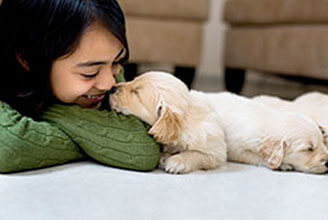Problem is, he seems to want to chew. Everything. All pet parents go through this initial phase of destruction that usually leaves us shaking our heads and telling our new pup he's lucky he's so cute.
Just like a human’s “terrible twos,” puppies go through an arduous growing process. They start teething, they don't understand the concept of house training and they want to play rough with everyone and everything they see, including your favorite pair of shoes, now shredded to pieces.
Puppy-proofing your home before your new puppy arrives can help protect him, as well as your furniture, carpet and garden.
Puppy-proofing tips
Walk around your home, viewing it through canine eyes. Look for potential hazards and items you don't want your puppy to chew. If he can reach it, it's fair game for chewing and eating.
- Kitchen – A playground of amazing smells and tastes for your puppy, kitchen cabinets and trashcans are way too tempting. If he gets into them, you’ll most likely find the contents decorating your floor.
Outfitting cabinets with childproof latches can prevent curious pups from investigating. If your garbage bin doesn't fit in a cabinet, consider hiding it where your puppy can't tip it over.
- Bedroom and bathroom – Your mother was right: Clean your room! Dogs rely heavily on their sense of smell and gravitate toward anything that smells like you so keep dirty clothing in a secure hamper, store shoes away and close your closet door.
Jewelry and hair ties and other small accessories should be stored in secure containers or drawers, well out of paw’s reach.
- Living areas – Clear away clutter in areas where you and your family spend the most time. Tuck pillows and blankets away in decorative bins and loop cords through PVC poles to prevent chewing.
While pet-proof furniture and pet-proof carpeting is ideal, proper training is best. You can't clear everything from your house, so be sure to redirect your puppy's attention to veterinarian- approved dog toys.
Pet Proof Furniture Tip: Try bitter apple spray or other spicy, bitter taste deterrents (think: garlic, hot peppers) to protect furniture. Perfumes can also be foul-tasting chew stoppers. Always check with your veterinarian before you use taste deterrents, especially on your dog’s fur if you want to curb self-biting.
- Dog-proof garden – Please check with your veterinarian on when it's ok for your puppy to venture outside. You may think the space outside your home is safe for your puppy but you need to check for and remove any poisonous plants.
Tiny stones and pebbles can also be an issue if your pup tries to eat one. Watch out for things you can’t see, like herbicides and pesticides.
Garage and driveway hazards –
Keep automotive and seasonal products like road salt and antifreeze out of pet’s reach. It may be easier to forego chemical items and buy pet-safe items only, especially for driveways and sidewalks your dog can’t avoid.
Common “stop-chewing” mistakes
Many first-time pet parents follow the advice of the first person or website to answer the burning question, "How to get puppies to stop chewing?"
But each individual dog has a unique learning method that may not be suited to particular training techniques. No matter what method of training fits your pup best, patience is always key.
Avoid typical training traps and practice these tips
- No emotion – Reacting emotionally is hard to stifle when you find your expensive leather furniture nearly destroyed from puppy chewing.
However, it's best to take a calm, indifferent stance. Bringing too much energy to the training can make your puppy more energized and anxious himself.
- Redirecting vs. punishing – Puppies teethe like human babies. Removing the object that's become a chew toy can create anxiety and discomfort that may lead to an even bigger outburst or possibly more harmful chewing toward himself or other furry family members.
Instead of removing your puppy from the scene and punishing him, give him something he can chew on. This requires careful monitoring so you can give your puppy a proper chew toy as soon as you see him making a beeline for your favorite shoes. - Avoid confusion and be consistent – Reward good behavior consistently and avoid mixed messages. If your puppy is attracted to shoes and socks, don’t give him an old pair to chew, even if they’re riddled with holes. Conflicting messages will confuse your pup and muddle the training you’ve already accomplished.
- Proactive vs. reactive – Puppies require constant scrutiny. Discovering a chewed carpet, claw marks on doors or furniture after the fact is a missed opportunity to do anything other than clean up.
You must be one step ahead of your chew-curious pup and be ready to redirect him.
This is when crate training is a real asset. See how it’s done at: http://bluebuffalo.com/articles/dog/8-12-weeks.
Yes, puppy-proofing your home takes work and commitment, but it's well worth it to get your relationship with your new furry family member off on the right paw.





